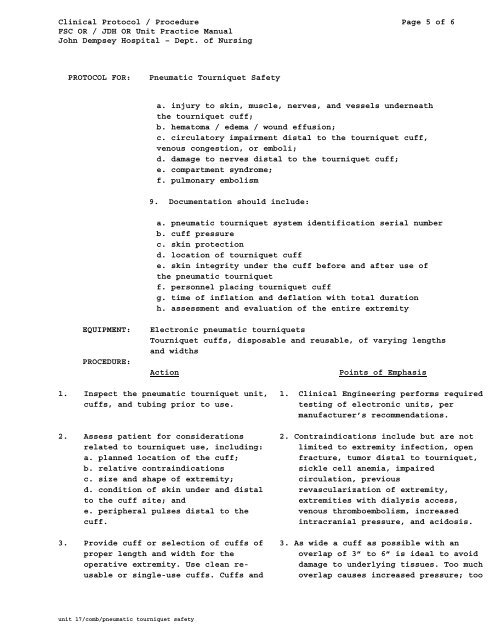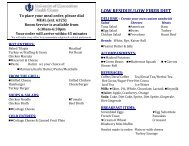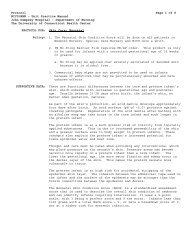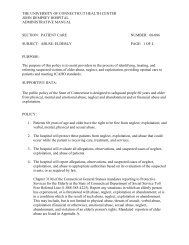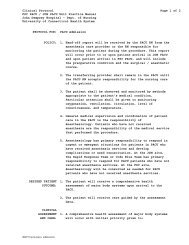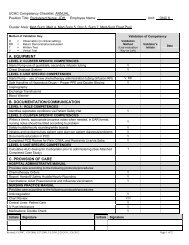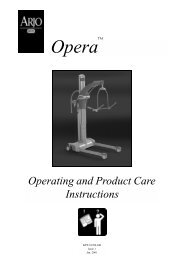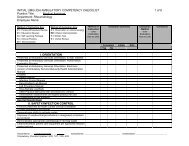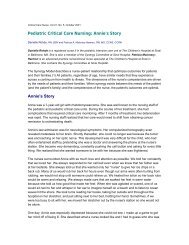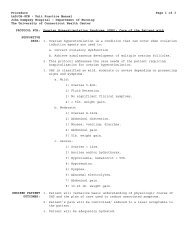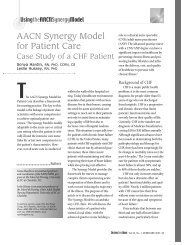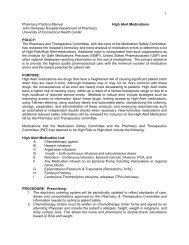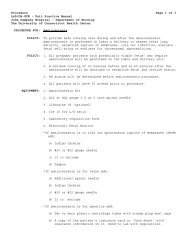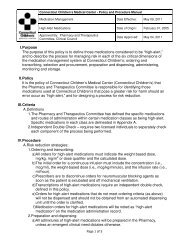Pneumatic Tourniquet Safety
Pneumatic Tourniquet Safety
Pneumatic Tourniquet Safety
Create successful ePaper yourself
Turn your PDF publications into a flip-book with our unique Google optimized e-Paper software.
Clinical Protocol / Procedure Page 5 of 6<br />
FSC OR / JDH OR Unit Practice Manual<br />
John Dempsey Hospital – Dept. of Nursing<br />
PROTOCOL FOR:<br />
<strong>Pneumatic</strong> <strong>Tourniquet</strong> <strong>Safety</strong><br />
a. injury to skin, muscle, nerves, and vessels underneath<br />
the tourniquet cuff;<br />
b. hematoma / edema / wound effusion;<br />
c. circulatory impairment distal to the tourniquet cuff,<br />
venous congestion, or emboli;<br />
d. damage to nerves distal to the tourniquet cuff;<br />
e. compartment syndrome;<br />
f. pulmonary embolism<br />
9. Documentation should include:<br />
a. pneumatic tourniquet system identification serial number<br />
b. cuff pressure<br />
c. skin protection<br />
d. location of tourniquet cuff<br />
e. skin integrity under the cuff before and after use of<br />
the pneumatic tourniquet<br />
f. personnel placing tourniquet cuff<br />
g. time of inflation and deflation with total duration<br />
h. assessment and evaluation of the entire extremity<br />
EQUIPMENT:<br />
PROCEDURE:<br />
Electronic pneumatic tourniquets<br />
<strong>Tourniquet</strong> cuffs, disposable and reusable, of varying lengths<br />
and widths<br />
Action<br />
Points of Emphasis<br />
1. Inspect the pneumatic tourniquet unit,<br />
cuffs, and tubing prior to use.<br />
2. Assess patient for considerations<br />
related to tourniquet use, including:<br />
a. planned location of the cuff;<br />
b. relative contraindications<br />
c. size and shape of extremity;<br />
d. condition of skin under and distal<br />
to the cuff site; and<br />
e. peripheral pulses distal to the<br />
cuff.<br />
3. Provide cuff or selection of cuffs of<br />
proper length and width for the<br />
operative extremity. Use clean reusable<br />
or single-use cuffs. Cuffs and<br />
1. Clinical Engineering performs required<br />
testing of electronic units, per<br />
manufacturer’s recommendations.<br />
2. Contraindications include but are not<br />
limited to extremity infection, open<br />
fracture, tumor distal to tourniquet,<br />
sickle cell anemia, impaired<br />
circulation, previous<br />
revascularization of extremity,<br />
extremities with dialysis access,<br />
venous thromboembolism, increased<br />
intracranial pressure, and acidosis.<br />
3. As wide a cuff as possible with an<br />
overlap of 3” to 6” is ideal to avoid<br />
damage to underlying tissues. Too much<br />
overlap causes increased pressure; too<br />
unit 17/comb/pneumatic tourniquet safety


